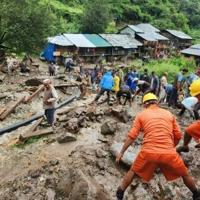Flash floods triggered by monsoon rains have resulted in the loss of 13 lives in the Himalayan foothills of India, as reported by officials on Friday. Helicopters have been deployed to rescue hundreds of people stranded near a famous Hindu shrine.
During India’s monsoon season, which is known for its heavy rainfall and landslides, widespread devastation is a common occurrence. However, experts suggest that climate change is now causing these events to happen more frequently and with greater severity.
According to disaster official Vinod Kumar Suman, there have been 13 reported deaths in the northern state of Uttarakhand. District officials have stated that around 700 individuals were rescued by helicopters while en route to the Kedarnath temple, a revered pilgrimage site dedicated to the Hindu deity Shiva.
Suman mentioned, “We are using multiple choppers to evacuate the pilgrims who were on their way.” Situated at an altitude of nearly 3,600 meters (11,800 feet) above sea level, the temple can only be accessed during the summer through a challenging 22-kilometer (14-mile) uphill trek.
Every year, the temple attracts thousands of worshippers during the peak monsoon season. The monsoon rains that occur from June to September in the region provide relief from the summer heat and play a critical role in replenishing water sources.
Furthermore, these rains are essential for agriculture, supporting the livelihoods of millions of farmers and ensuring food security for nearly two billion people in South Asia.
This week, over 200 individuals lost their lives in the southern state of Kerala due to landslides in villages and tea plantations, with ongoing search and rescue efforts. Additionally, two individuals were reported dead in the neighboring state of Himachal Pradesh this week, where rescue teams are still searching for more than two dozen missing individuals.
str-sai/gle/fox





